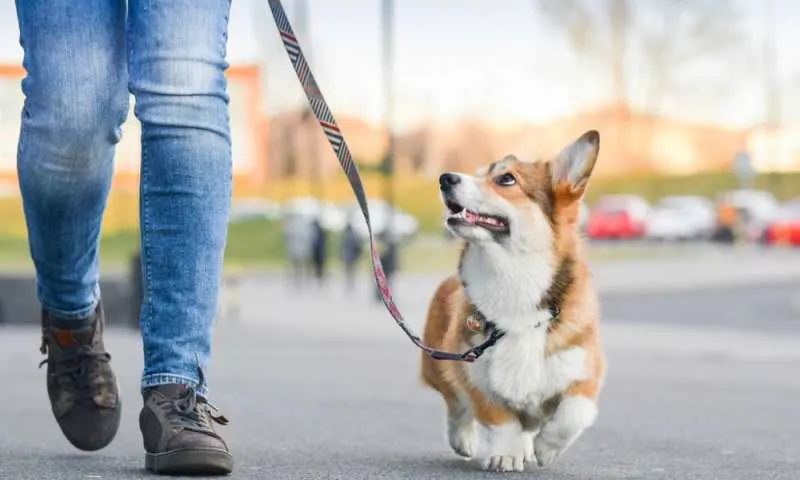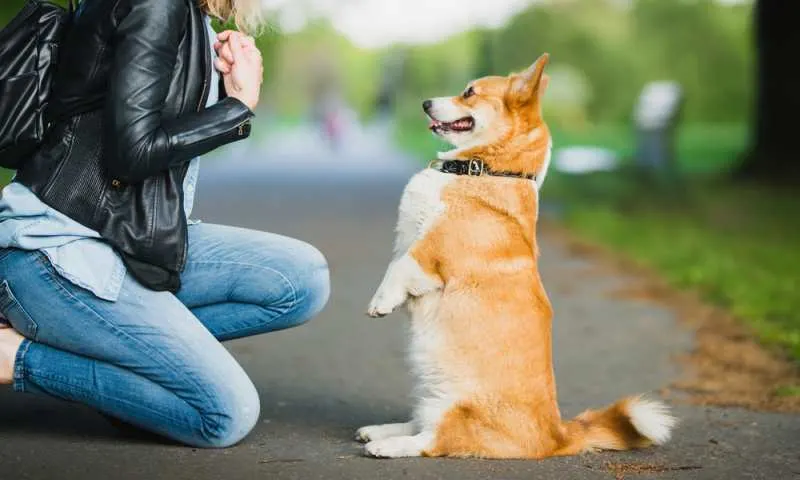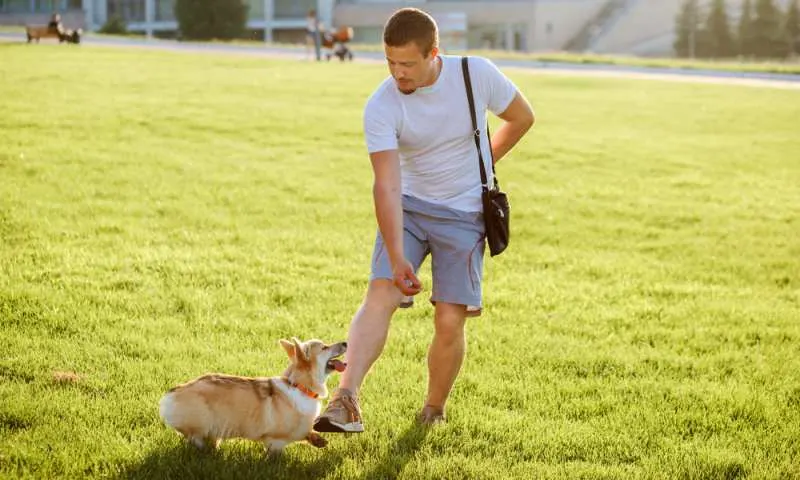There are basic, intermediate, and advanced commands your corgi can listen to and obey. One of the most well-known is the “heel” command. So in order to begin your corgi’s training as you should, I’m going to teach you how to train a corgi to heel.
As I already said, this is one of the easiest and most basic commands you can give to your dog and it’s crucial that they learn it as soon as possible besides the “sit” command.
The heel command is used to call your corgi back to you and to let them know that you want them to stay by your side until you give them the next command.
In order to learn the intricacies of this command and how to properly train your corgi to do it every time you want them to, you’ll have to know a few things about how this command works and what preconditions you must fulfill.
Don’t worry, even though this sounds quite complicated, I promise it’s not. If you follow my guide on how to do this, your corgi will be right there by your side in just a couple of seconds every time you want them to. Now, without further ado, let’s dive right in and see how to do this in the easiest way possible!

What Does “Heel” Command Mean?
First, you’ll have to understand what you’re teaching your dog. Many people think it’s just a command to tell your dog you want them on a specific side of your body as close to your heel as possible.
But there are variations of this command that are used for so much more, so it seems it would be best if I listed all the variations I will cover today and how to successfully teach them to your corgi.
The variations you’ll learn about today:
- Classic heel
- Between the legs heel
- Switching heel
- Backward heel
- On and off the leash heel
As you can see there are much more variations of this command than you probably thought. Just for the sake of simplicity, I will now give you an explanation on every single one of these just to make it easier for you to understand the goal of the training for each and every one of these.
Classic Heel
This variation is the most common one where the owner calls their dog to come and stand by their less dominant side. A big majority of dog owners use this one to train their dog’s obedience and discipline as it is the easiest one to learn and continuously use.
Between The Legs Heel
Between the legs variation of this command is one of the most complicated ones to teach to your dog as it has two possible sub-variations. One is when your dog is approaching you from the back, and the other one is when your dog is approaching you from the front, which is the more complicated one.
Don’t worry, I’ll teach you how to do both of these so your dog won’t get confused in any kind of situation when given this command. Also, it’s quite important to emphasize that this variation needs to be practiced continuously as any dog (including corgis) can easily forget how to do it.
Switching Heel
Flashy moves that are easily thought are my favorite, and I bet they are your favorite as well! This one is exactly that. It looks fancy but is quite easy to teach your corgi to do. Corgis might have a bit of a problem with this one because of the length of their legs, but we’ll get to that soon enough and then I’ll teach you how to minimize potential complications when doing this variation of the heel command.
Backward Heel
This is also quite a good-looking variation but is also easily performed. It’s used when you train your dog to protect your back and is extremely represented in the guard dog community. It’s best taught to your dog after the classic variation as they have the movement down, but the direction they’re facing is different.
On And Off The Leash Heel
The importance of controlling your dog off the leash is maybe more important than when they’re on the leash. Dog parks and streets are not safe and you’ll have to train your dog to listen to you even if you aren’t in a position to yank them with their leash.
This is the command that is used exactly for that as it’s one of the fastest to give and the easiest to carry out by your dog. We’ll talk about how to get your dog’s attention when they’re off the leash and how to call them back to a “heel” position.
This is probably the hardest one to do as it requires the most effort and risk to get down to perfection. I recommend trying it inside, in your backyard (if you have one), or in a fenced-off dog park. Don’t worry, we’ll get to that as well, but for now, this is the most important thing to remember regarding this variation.
Learn More: Are Corgis Trainable? How Long To Train A Corgi?

How To Train A Corgi To Heel?
Training for most of these commands starts off the same way. It’s nothing too complicated but you’ll need a couple of things before you start to make your life easier while training. The things both you and your dog will need are:
- A leash
- Your dog’s favorite toy
- A ton of treats
You’ll start off by getting your dog’s attention on you by showing them a treat. After you’ve established the attention you need to wave the treat in order for your corgi to start coming your way.
Hold the treat in your dominant hand and start putting it in your non-dominant hand behind your back. By doing this you’re signaling the motion that your dog needs to do in order to get to your less dominant side by going behind your back.
Hold the treat high in your non-dominant hand and wait for your corgi to get into position. If they hurry with their movement and end up in front of you, move your body so they are in position. If they don’t move – give them the treat.
If they move or start jumping at the treat, take a few steps in any direction and try again. This is important because if you start rewarding your dog for not doing the things you want them to do, it’ll become a habit of theirs and they will always expect some treats from you.
The classic heel is successful if your dog makes a loop around you and steps right by your foot on your non-dominant side. Another good variation is if they approach you from the front and just rotate in order to get their body into position.
This varies from dog to dog, but both are quite good. If you want your corgi to approach you specifically from the front, I recommend you just wave the treat, tell them to sit and get yourself into a position where your dog is right by your side sitting.
Getting your corgi to stand between your legs is a bit trickier. Here you need to make a loop around your waist with the treat in your hand and pass it between your legs so your corgi follows the treat with its nose and gets into position.
When the corgi puts their butt down or starts barking at the treat while between your feet, carefully lower the treat and give it to them while they are still in position.
Switching your dog from side to side is easy. When they learn the classic heel command, just grab a treat and make a circular motion behind your back to the other side of your body. They’ll recognize that they need to follow the treat.
I highly suggest using a shouting phrase that is similar to “switch” because you’ll have a tough time explaining to your dog which side you want them on.
The backward heel is not done so easily. It’ll require you to get into the position multiple times to let your dog know what position you want them in. This is especially hard if your corgi already knows the classic heel because there is a possibility of them getting confused and getting into the stance for the classic variation.
The best thing you can do is not allow them and reposition them every time you see them go for a classic heel stance. Let them get into that position from time to time just to prevent them from thinking you don’t want them to do that exercise anymore.
I’ve purposefully left the trickiest one for the end. If you have a Flexi leash you won’t have a problem calling your dog back to your heel.
The problem arises when they’re off the leash and you want them to come back!
The way I used to do this is that I would get a huge rope that I would tie to my corgi’s collar. I’d step on the other end and let them roam free. If you give them 30 to 35 feet of space to run, they’ll feel like they don’t have a leash.
When they get far enough, call their name, raise the hand that you have your treat in, and shout the heel command.
The first time they come back to you in that environment is the time you need to give them the most praises and treats. You should do this because then they’ll remember that moment and always come back just for that. Don’t expect them to return every time, but the percentage of success will go up as time goes by.
Knowing this, you need to arm yourself with patience and a lot of treats. Trust me, it’ll be worth it in the end because this is the most useful command your dog can learn to obey.
The first time you try this without any kind of rope or leash, you should be in an area where your corgi can’t go into open traffic and where there aren’t a lot of things that can draw their attention. I recommend doing this in your backyard, but if you don’t have that, you can always figure out the time of the day when there aren’t many people and dogs in your dog’s favorite dog park and go there to practice.
Don’t panic if your dog doesn’t come to you right away, just be patient and wave the treats at them while repeating the command. Once they recognize that the prize is waiting for them, they’ll come. That’s the moment when you give them the treats and praise them for a job well done.
Until your corgi listens to the heel command off the leash 10 out of 10 times, don’t try doing it in an open field where they can run away and get lost.
Read Also: Can Corgis Walk Off Leash? Can Corgis Walk Far?

Conclusion
As you can see this isn’t a mission impossible. Corgis are quite a smart breed and they are able to learn virtually any trick in the book with enough exercise. You can see that from the answer to the question of how to train a corgi to heel.
I just advise you to be patient and to have hope that your dog will eventually get it down. Dogs, as smart as they are, need time to obey commands in repetition and require constant training to be able to do all the tricks and obey all commands in the long term.
So, arm yourself with patience, lots of treats, and an open field that has fences to release you from your worries.
Have fun, and stay safe!
Read Also: How To Train A Corgi To Lay Down? Extra Tips & Tricks

